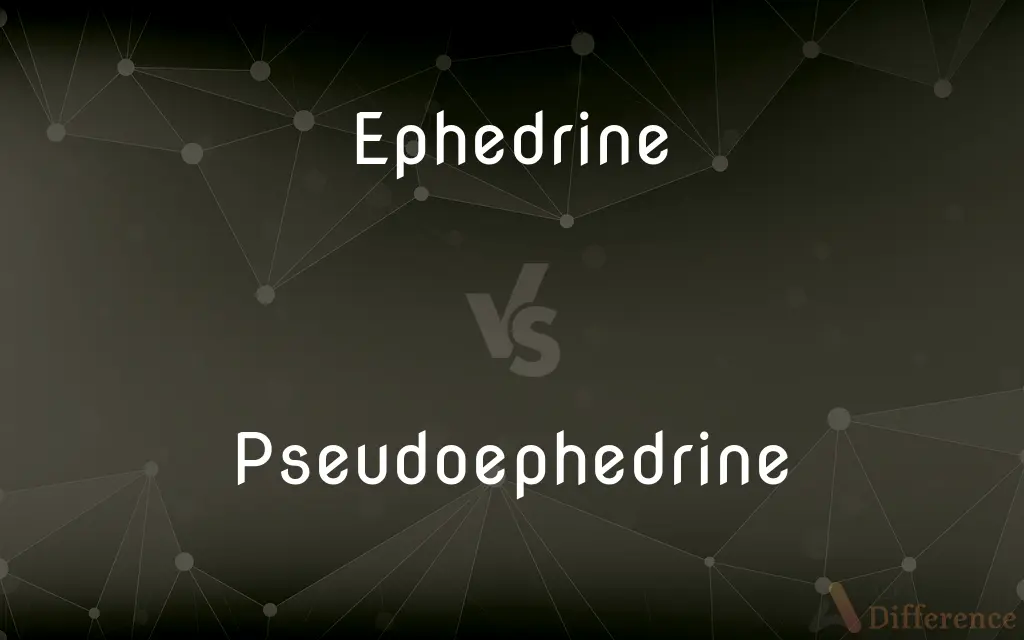Ephedrine vs. Pseudoephedrine — What's the Difference?
Edited by Tayyaba Rehman — By Fiza Rafique — Updated on October 5, 2023
Ephedrine is a stimulant used to treat low blood pressure, asthma, and nasal congestion. Pseudoephedrine is its diastereomer, primarily used as a nasal decongestant.

Difference Between Ephedrine and Pseudoephedrine
Table of Contents
ADVERTISEMENT
Key Differences
Ephedrine and Pseudoephedrine are both alkaloids that originate from the plant genus Ephedra. They're closely related chemically, but they have distinct uses and properties. Ephedrine acts as a central nervous system stimulant. It's often employed in the management of asthma due to its bronchodilation effects and has been used historically to treat low blood pressure.
On the other hand, Pseudoephedrine is a diastereomer of Ephedrine, meaning they have similar but not identical atomic arrangements. Pseudoephedrine's primary use is as a nasal and sinus decongestant in cold and allergy medications. Its effects are mainly peripheral, meaning it acts outside the central nervous system.
Ephedrine has faced restrictions due to its potential for misuse. In high doses or when improperly used, it can lead to severe cardiovascular events. Additionally, it's been utilized as a starting material for the illegal synthesis of methamphetamine, leading to stricter regulations.
Conversely, Pseudoephedrine, although also a precursor in illicit methamphetamine production, generally presents fewer central nervous system side effects than Ephedrine. However, due to its potential misuse, many countries regulate its sale, often requiring identification or limiting the purchase quantity.
In summary, while both Ephedrine and Pseudoephedrine have medical uses and come from similar origins, their primary applications and effects on the body differ. Ephedrine is more of a systemic stimulant, while Pseudoephedrine's primary role is as a decongestant.
ADVERTISEMENT
Comparison Chart
Origin
Derived from Ephedra plants.
Diastereomer of Ephedrine.
Primary Medical Use
Treat asthma, low blood pressure.
Nasal decongestant.
Mechanism of Action
Central nervous system stimulant.
Acts mainly peripherally.
Associated Risks
Cardiovascular events, misuse.
Limited central nervous system effects, but potential for misuse.
Regulation
Restricted due to potential for misuse.
Sale often regulated due to methamphetamine production concerns.
Compare with Definitions
Ephedrine
A stimulant derived from Ephedra plants.
Ephedrine has been used in traditional medicine for respiratory ailments.
Pseudoephedrine
A decongestant for nasal and sinus congestion.
Many over-the-counter cold remedies contain pseudoephedrine.
Ephedrine
A compound known to stimulate the central nervous system.
Overconsumption of ephedrine can lead to restlessness and insomnia.
Pseudoephedrine
A compound closely related to ephedrine.
Although similar, pseudoephedrine has different primary uses than ephedrine.
Ephedrine
A bronchodilator for asthma treatment.
Some asthma patients are prescribed ephedrine for relief during an attack.
Pseudoephedrine
A regulated substance due to potential misuse.
Purchasing large quantities of pseudoephedrine may raise suspicion due to its association with illegal drug production.
Ephedrine
A medication for increasing blood pressure.
Ephedrine can be administered to stabilize patients with dangerously low blood pressure.
Pseudoephedrine
Effective in relieving stuffy nose symptoms.
Pseudoephedrine can offer relief during allergy season.
Ephedrine
A precursor in illegal methamphetamine production.
Due to its misuse, ephedrine sale is often regulated.
Pseudoephedrine
Mainly acts outside the central nervous system.
Unlike ephedrine, pseudoephedrine's effects are primarily peripheral.
Ephedrine
Ephedrine is a medication and stimulant. It is often used to prevent low blood pressure during spinal anesthesia.
Pseudoephedrine
Pseudoephedrine (PSE) is a sympathomimetic drug of the phenethylamine and amphetamine chemical classes. It may be used as a nasal/sinus decongestant, as a stimulant, or as a wakefulness-promoting agent in higher doses.It was first characterized in 1889, by the German chemists Ladenburg and Oelschlägel, who used a sample that had been isolated from Ephedra vulgaris by the Merck pharmaceutical corporation of Darmstadt, Germany.
Ephedrine
A white, odorless, powdered or crystalline alkaloid, C10H15NO, isolated from shrubs of the genus Ephedra or made synthetically. It is used in the treatment of allergies and asthma.
Pseudoephedrine
An isomer of ephedrine, C10H15NO, used in its hydrochloride or sulfate form as a nasal decongestant.
Ephedrine
A crystalline alkaloid drug C10H15NO obtained from a Chinese ephedra (Ephedra sinica) or synthesized that has the physiological action of epinephrine. It causes constriction of the blood vessels and widening of the bronchial passages and is used in the form of its hydrochloride or sulfate to relieve asthma and hay fever.
Pseudoephedrine
(pharmaceutical drug) A sympathomimetic alkaloid commonly used as a decongestant; a chemical compound, an isomer of ephedrine, with the formula C10H15NO.
Ephedrine
White odorless powdered or crystalline alkaloid from plants of the genus Ephedra (especially Ephedra sinica) or made synthetically; used as a bronchodilator to treat bronchitis and asthma
Pseudoephedrine
Poisonous crystalline alkaloid occurring with ephedrine and isomorphic with it
Common Curiosities
Why are sales of both compounds regulated?
Their potential as precursors for methamphetamine production.
Are ephedrine and pseudoephedrine interchangeable?
No, they have different primary uses and effects.
Share Your Discovery

Previous Comparison
Journalist vs. Reporter
Next Comparison
Magnetite vs. HematiteAuthor Spotlight
Written by
Fiza RafiqueFiza Rafique is a skilled content writer at AskDifference.com, where she meticulously refines and enhances written pieces. Drawing from her vast editorial expertise, Fiza ensures clarity, accuracy, and precision in every article. Passionate about language, she continually seeks to elevate the quality of content for readers worldwide.
Edited by
Tayyaba RehmanTayyaba Rehman is a distinguished writer, currently serving as a primary contributor to askdifference.com. As a researcher in semantics and etymology, Tayyaba's passion for the complexity of languages and their distinctions has found a perfect home on the platform. Tayyaba delves into the intricacies of language, distinguishing between commonly confused words and phrases, thereby providing clarity for readers worldwide.
















































